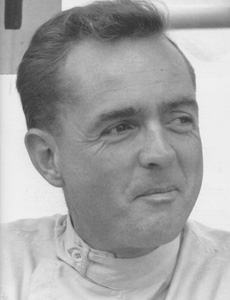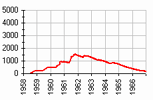Гонщики, H | |
Hill, Phil Курсивом отмечены гонщики, |
| Фил ХиллHill, Phil |
 (c) 'Who is Who' by Steve Small, 2000 Родился: 20.04.1927 Майами, Флорида Умер: 28.08.2008 Монтерей, Калифорния Сезонов в Ф1: Лет в Ф1: 9 Гран При: Старты: 48* *не стартовал: 5 Победы: - подряд: Подиумы: - подряд: 3 Поул-позиции: - подряд: 5 Первый ряд: - подряд: 5 Быстрые круги: - подряд: Лучший финиш: Лучший старт: 1 Дубли: Хет-трики: 1 Лидирование старт/финиш: Большие шлемы: |
Год | Команда | Шасси |
Phil Hill is always remembered as the man who became America's first World Champion when he took the crown driving a Ferrari in 1961, yet that season he won only two Grands Prix and they were his only victories in small-capacity racing cars. In a long career he was overwhelmingly more effective and successful in big, powerful sports machines.
After business studies on the west coast, Phil decided he preferred working on cars to the office life and by 1950 he was racing an MG TC, which was duly replaced by a succession of machines all of which were hard-earned by the sweat of his brow. In 1952 he got a big break with a drive in Alan Guiberson's Ferrari, taking sixth place in the Carrera Panamericana, but the following year he fared badly and briefly considered retirement. He was persuaded to continue, however, and second place in the 1954 Carrera was a marvellous morale-booster. His career then took off in a big way Stateside, Phil winning the 1955 SCCA championship, and after he had finished second in the 1956 Buenos Aires 1000 Km he was given a contract to drive sports cars for the Scuderia. He won the Swedish GP and the Messina 5 Hours that season in works cars, and added more good results the following year, including a win in the Venezuelan GP at Caracas with Peter Collins.
By 1958 Phil was itching to get his hands on a Grand Prix car, but Ferrari seemed unwilling to give him the opportunity he craved, save for a little practice at the Libre Buenos Aires GP. Enzo felt he was best suited to sports cars, and Hill proved as much when he won at Buenos Aires and Sebring and then put in a brilliant drive in the wet to win Le Mans with Gendebien. However, by now his need to race in Formula 1 bordered on the obsessional and he hired Bonnier's Maserati to give himself a debut at the French GP. Perhaps Ferrari took the hint because come the German GP Hill was handed the team's F2 car, and then at Monza he was entrusted with the real thing - a Ferrari 246 - taking third and fastest lap. By backing off at the finish of the Moroccan GP to allow Hawthorn to move into second place and thus take the championship, Phil did his standing no harm and he became a full-time Grand Prix team member thereafter. He spent 1959 learning the art of Grand Prix driving, sometimes proving a little ragged in his approach and indulging in some hairy moments, but taking fourth place in the championship nevertheless. By 1960 the big front-engined cars were almost on the point of obsolescence, but Hill gave the dinosaurs one last hurrah by winning the rather hollow Italian GP held on Monza's banked circuit which was boycotted by the British teams.
The following season was to be his finest. In addition to winning the Sebring 12 Hours and Le Mans for the second time with Gendebien, he took the little 'shark-nose' Ferrari to victory at Spa and Monza to be crowned as World Champion in the saddest of circumstances following the terrible death of his team-mate and championship rival Wolfgang von Trips. Things progress quickly in Formula 1, however, and in 1962 Ferrari were totally eclipsed, leaving Phil with a few placings but no hope of defending his title. He was still regarded as one of the finest exponents of sports car racing, however, and confirmed it by winning Le Mans for the third time with Gendebien, as well as the Nürburgring 1000 Km.
Such was the disharmony at Maranello that year that Phil joined what was effectively a breakaway group to race the ATS in 1965. To say it was a disastrous move would be an understatement, and it effectively destroyed his Grand Prix career. Initially left without a drive, he was called into the Cooper team following the tragic loss of Tim Mayer at Longford, but it was an unhappy liaison, with Phil's confidence hitting rock bottom at Zeltweg where he wrote off two cars. This resulted in the ignominy of his being dropped for Monza, but he was reinstated for the final two races.
Save for a drive in Gurney's Eagle at Monza in 1966, his Grand Prix career was done, but he still had something left. He had been a key member of the Ford works sports car effort in 1964-65, but a move to Jim Hall's Chaparral team gave the twilight of his career a final glow. In 1966 he won the Nürburgring 1000 Km with Bonnier, and a Can-Am round at Laguna Seca, and in his final season he took a memorable victory at Brands Hatch sharing the Chaparral 2F with Mike Spence.
After this last win he drifted into contented retirement, restoring vintage cars and keeping in touch with the sport in a commentary role. Currently he is a regular participant in historic events and no doubt watches with satisfaction the promising progress of his son Derek in the junior formulae.
(c) 'Who is Who' by Steve Small, 2000
| © WildSoft, 1995-2020 |


